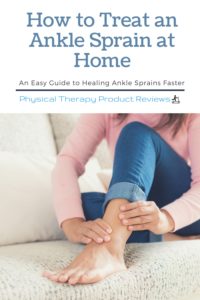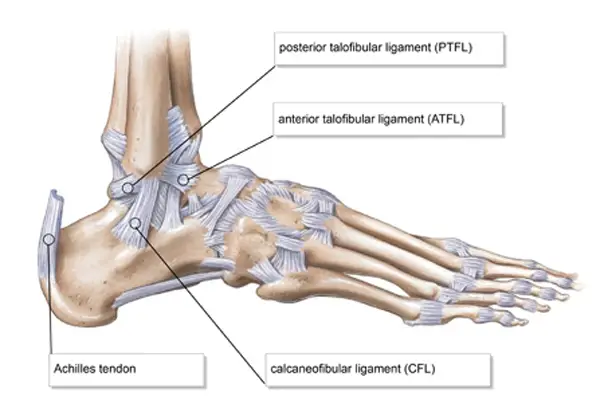A sprained ankle is one of the most common injuries to the lower body, occurring at a frequency of 600-700 per 100,000 people (1). This number increases with participation in sports, and accounts for nearly 22% of all emergency room visits in athletes (2). The most common ankle sprain is a lateral ankle sprain. This makes up nearly 85% of all ankle injuries, with inversion or rolling of the foot inward being the most common mechanism of injury (3).
 Once an ankle sprain has occurred, symptoms may remain for a long time! In as many 30% in the general population symptoms can be come chronic in nature (4). Not only can symptoms become chronic but once you sustain an ankle sprain, you’re at an increased risk for a second sprain. A history of ankle sprain is the single best predictor of a sustaining a future ankle sprain (5). This is one reason why it is important to treat the first one ankle sprain properly to avoid it becoming an issue down the road.
Once an ankle sprain has occurred, symptoms may remain for a long time! In as many 30% in the general population symptoms can be come chronic in nature (4). Not only can symptoms become chronic but once you sustain an ankle sprain, you’re at an increased risk for a second sprain. A history of ankle sprain is the single best predictor of a sustaining a future ankle sprain (5). This is one reason why it is important to treat the first one ankle sprain properly to avoid it becoming an issue down the road.
What is a Sprained Ankle?
An ankle sprain is when you roll the ankle sideways and stretch or tear the ligaments of the ankle. Most people have experienced this at sometime in your life such as when stepping off a curb, stepping in a whole, or landing on someone else’s foot in a sporting event.
An example for an everyday person is walking and not paying attention, when you step on a rock. Your foot rolls inward, you quickly pick up your foot but it’s too late. The outside of the foot and ankle is now painful and depending on the severity, can be difficult to put weight on it.
Most of the time you try to walk it off and take a few steps to see if the pain decreases. Fortunately, most of the time it does with just a little residual soreness. But what if it doesn’t? What if that pain lingers and remains weeks after? We’re here to help.
Severity of Ankle Sprain Grades
Ankle sprains come in 3 different grades depending on the amount of injury and ligament stretch. See if you can identify the ligaments affected with each grade of ankle sprain.
Grade 1 Ankle Sprain (Mild):
- Mild stretching of or microscopic tearing of the ligament on the outside ankle – ATFL ligament is most commonly affected
- Mild swelling and discomfort with weight bearing
- Usually heals quickly (2-3 weeks) with ice and rest

Grade 2 Ankle Sprain (Moderate):
- Mild/mod swelling with increased pain during weight bearing
- May walk with a limp
- Partial tearing of the ligaments on the outside of the ankle – ATFL and CFL ligaments most commonly impacted
- May experience increased laxity during movement and feeling of giving out early on
- Takes a little bit longer to heal with a general time frame of 4-6 weeks
- May need to wear a CAM boot for walking
Grade 3 Ankle Sprain (Severe):
- Considerable tenderness, swelling, bruising, and pain
- May not be able to bear weight for the first week or two and may need to use crutches
- Moderate/complete tearing of the ligaments on the outside of the ankle – ATFL, CFL, and PTFL are all impacted
- Much longer time to heal with a general timeline of 6-12 weeks depending on several factors
- Greatest lost of balance and stability when standing
Most ankle injuries do not require surgery and heal with conservative treatment and time. Grade 1 ankle sprains can usually be treated at home with minimal intervention. Grade 2-3 often require more a involved recovery and may benefit from seeing a medical professional. Often times a quality ankle brace can get you through the painful state and you can be on your way. See our post on the Best Ankle Braces found on Amazon here.
When to see a Doctor after a Sprained Ankle?
Most of the time mild and moderate ankle sprains do not require a visit to your doctor. However here are some instances that make warrant a visit to a physician.
- Inability to bear weight immediately after the injury and within 48 hours
- Misalignment of the bones of the lower leg
- Bleeding or immediate change of color with loss of pulse
- Numbness and tingling that is getting worse
- Severe, unimaginable pain when touching the bones of the lower leg
When you do sprain your ankle it is paramount that you continue to try and walk on it and put weight on it as much as possible. Even though initially it will likely hurt it does speed up recovery and help determine the severity of the injury. If you still cannot walk without pain and do not want to spend the $800 for a doctor visit, negative x-rays, and an overpriced boot; then you should order a CAM boot and wear it for 2 weeks and re-assess.
How to Treat an Ankle Sprain at Home
The treatment for ankle sprains at home is divided into 3 distinct phases. The time needed in each phase is dependent on many different factors including the severity of the sprain, job duties at work, and the prior history of injuries. Time frames are listed for generalization and may be different for each individual person. As always please consult your physician before starting any exercise program.
Ankle Sprain Rehab Phase 1 – Rest and Healing Phase (1-3 weeks)
During this phase of treatment the primary goal is to allow for healing to occur. You want to control the swelling, control the pain, and try to increase weight bearing as your pain decreases. During this time is it important to not do too much, yet we don’t want it to completely stiffen up either.
- This is the time for the R.I.C.E Protocol – Rest, Ice, Compression, and Elevation
- The use of an ankle brace may help to begin increasing bearing weight in the ankle – soft sided bracing has better outcomes as opposed to a hard casts for mild and moderate sprains (6)
- The use of manual therapy and massage to improve range of motion and pain may be effective in the short term (7)
- Begin gentle ROM exercises such as ankle pumps, foot ABC’s, and towel scrunches
- If you are limping it is recommended that you use crutches until you can bear weight pain free
- Use a stationary bike to maintain your current fitness levels
Beneficial Items for Phase 1
Click on Image for More Information
Click on Image for More Information
A Compression Sock for Swelling
Click on Image for More Information
Click on Image for More Information
Ankle Sprain Rehab Phase 2 – Increase Movement and Strength (2-6 weeks)
During this phase of treatment the pain and swelling should be starting to decrease and it is time to focus improving the motion and strength in the ankle. The treatment and activity in this phase should be relatively pain free, with mild discomfort at end range stretching. If there is any sharp pain or increase in swelling, back it off slightly.
- Begin Theraband exercises for ankle strength
- Begin calf raise progression
- Begin stretching program and self ankle joint mobility
- Should be off the crutches at some point in this time periods but may still need a brace for pain free normal walking or sports participation
Beneficial Items for Phase 2
Calf StretcherClick on Image for More Information
Click on Image for More Information
Click on Image for More Information
Aerobic Step for Strengthening
Click on Image for More Information
Ankle Sprain Rehab Phase 3 – Improve Balance and return to Dynamic Activity (6-12 weeks)
In this phase the emphasis is returning to normal with both static and dynamic balance, and return to dynamic activity which includes running, jumping, and lateral movement. Even if you are not an athlete, this phase is still extremely important to develop the foot awareness and balance to avoid Chronic Ankle Instability and have problems long term.
- Improve single leg balance with eyes open and more importantly eyes closed
- Begin a plyometric program for load progression
- Beginning a jogging program starting at much less time and distances than you were at before the injury
- May still need a lace up brace as you return to playing competitive sports
Now is the time in rehab that you can start to incorporate normal activities such as walking, running, and jumping. For the weekend warriors and gym rats, its time to start preparing for your return to sport activities.
Functional Activities:
- Box jumps
- Scissor jumps
- Bounding
Box Jumps
Scissor Jumps
Bounding
Bosu Ball For Ankle Sprains
One of the best ways to improve ankle instability and strength after an ankle sprain is to use a bosu balance trainer.
Disclaimer: Please consult your physician before performing any exercise program or taking any over the counter drug or medication. This is for informational purposes only and should always speak to your physician or physical therapist prior.
Works Cited
- Bengner U, Johnell O, Redlund-Johnell I. Epidemiology of ankle fracture 1950 and 1980: increasing incidence in elderly women. Acta Orthop Scand 1986;57: 35–7 – https://www.tandfonline.com/doi/abs/10.3109/17453678608993211
- Boyce SH, Quigley MA. Review of sports injuries presenting to an accident and emergency department. Emerg Med J2004;21: 704–6 – https://www.ncbi.nlm.nih.gov/pmc/articles/PMC1726501/
- Hertel J. Functional anatomy, pathomechanics, and pathophysiology of lateral ankle instability. J Athl Train 2002;37: 364–75 – https://www.ncbi.nlm.nih.gov/pmc/articles/PMC164367/
- Van Rijn RM, van Os AG, Bernsen RM, Luijsterburg PA, Koes BW, Bierma-Zeinstra SM. What is the clinical course of acute ankle sprains? A systematic literature review. Am J Med 2008;121: 324–31, e326 – https://www.amjmed.com/article/S0002-9343(07)01191-6/fulltext
- Hiller CE, Refshauge KM, Herbert RD, Kilbreath SL. Intrinsic predictors of lateral ankle sprain in adolescent dancers: a prospective cohort study. Clin J Sport Med 2008;18: 44–8 – https://insights.ovid.com/crossref?an=00042752-200801000-00009
- Kerkhoffs GM, Rowe BH, Assendelft WJ, Kelly KD, Struijs PA, van Dijk CN. Immobilisation and functional treatment for acute lateral ankle ligament injuries in adults. Cochrane Database Syst Rev 2002;3: CD003762. – https://www.cochranelibrary.com/cdsr/doi/10.1002/14651858.CD003762/full
- Eisenhart AW, Gaeta TJ, Yens DP. Osteopathic manipulative treatment in the emergency department for patients with acute ankle injuries. J Am Osteopath Assoc2003;103: 417–21 – https://jaoa.org/article.aspx?articleid=2092980
Other Great Rehab Related Articles
How to Stay Active After Cervical Fractures: Expert Tips and Advice
Dealing with Painful Stairs After Ankle Replacement Surgery
Walking After a Total Ankle Replacement: Tips for a Successful Recovery
Exercises While Non-Weight Bearing After Ankle Replacement: Elevation, AROM, Leg Raises, and More
Ankle Pain with Stairs: Causes and Home Treatment Options
5 Common Mistakes You’re Making After an Ankle Sprain
Disclaimer: The information provided in this post is for educational purposes only. This is not a substitute for a medical appointment. Please refer to your physician before starting any exercise program.















